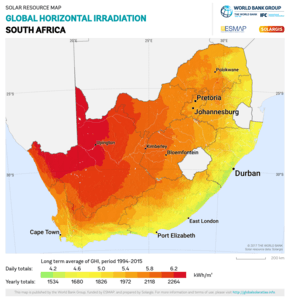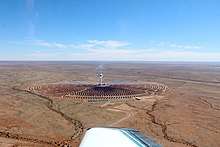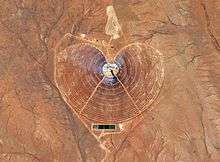Solar power in South Africa
Solar power in South Africa includes photovoltaics (PV) as well as concentrated solar power (CSP). In 2016, South Africa had 1,329 MW of installed solar power capacity.[1] Installed capacity is expected to reach 8,400 MW by 2030.[2]

In 2014 several solar farms were commissioned, including the 96 MW Jasper Solar Energy Project, one of Africa's largest photovoltaic power stations providing enough solar power for 30,000 homes.[3]
Government Programs
As of 1 January 2016 the South African government gave a tax incentive through the South African Revenue Service for the installation of photovoltaic solar energy generation systems. Depending on the size defined in MWp (Megawatt peak) of the photovoltaic solar system, the amended section 12 B of the Income Tax Act No. 58 of 1962 stipulates the size of the tax shield available through accelerated depreciation to the commercial tax paying entity.[4][5]
Photovoltaic solar systems smaller or equal to 1 MWp can be depreciated in one year, granting the commercial tax paying entity a 28% discount on the system. The tax shield applies even if the photovoltaic solar system is installed mid-year[6] or if the system is not new.[7] A repayment time of one year and ongoing electricity savings for the remainder of the system's lifetime can be achieved by financing a portion of the cost of the system.[8] Photovoltaic solar systems greater than 1 MWp are depreciated with the schedule 50%, 30%, and 20% in the first 3 years respectively.
Adoption and Government Conflict of Interest
Despite this aggressive tax incentive, South African companies are slow to adopt grid-connected photovoltaic solar systems due to the lack of public dialogue from the government concerning photovoltaic solar energy.
The lack of public dialog is partially due to the conflict that arises between the government, its state-owned enterprise Eskom, the local renewable energy sector as well as international obligations such as the Kyoto Protocol and the Paris Agreement of which South Africa is a signatory. The state-owned electricity utility Eskom that provides 90%[9] (85%[10] from coal) of South Africa's electricity and depends on electricity sales to function. Due to alleged corruption and mismanagement of funds in the years leading up to 2017,[11][12] Eskom has been forced to increase tariffs by 340% over 10 years.[13] Despite this tariff increase Eskom is in poor financial health as of 2017. The utility has stated that the increase in renewable energy generation directly impacts its revenue stream, which makes it difficult for it to meet its debt obligations. A government bailout has not been ruled out. The utility, relying mainly on coal-fired power stations also fears that renewable energy generation will directly impact coal jobs.[14]
Through its holding in Eskom, the South African government is dependent on Eskom's revenue stream to avoid a bailout with public funds.[15]
Municipal Programs
In addition to the government tax incentive for photovoltaic solar energy generation, certain municipalities have further incentives for residential and commercial customers, such as a feed-in tariff or net metering.
| Name | Seat | Type | Notes | Link |
|---|---|---|---|---|
| City of Johannesburg Metropolitan Municipality | Johannesburg | Feed-In-Tariff | Embedded Generation ≤1 MW
Residential: R0.4279/kWh Commercial: R0.3614/kWh |
City Power |
| City of Cape Town Metropolitan Municipality | Cape Town | Feed-In-Tariff | Small-scale Embedded Generation ≤1 MW
Residential: R0.7008/kWh Commercial: R0.7008/kWh |
City of Cape Town |
| eThekwini Metropolitan Municipality | Durban | Feed-In-Tariff | Residential Embedded Generation
Single Phase: ≤2.6 kW Three Phase: ≤13.8 kW Residential: R0.68/kWh |
Ethekwini Municipality |
| Ekurhuleni Metropolitan Municipality | Germiston | n/a |
|
City of Ekhuruleni |
| City of Tshwane Metropolitan Municipality | Pretoria | n/a |
|
City of Tshwane |
| Nelson Mandela Bay Metropolitan Municipality | Port Elizabeth | Net Metering | Small-scale Embedded Generation ≤1 MW
Residential: 100% of electricity cost Minimum cost: R0.00 Up to 1 year credit when monthly generation exceeds consumption |
Nelson Mandela Bay SSEG Application |
| Buffalo City Metropolitan Municipality | East London | n/a |
|
Buffalo City Metropolitan Municipality Tariffs |
| Mangaung Metropolitan Municipality | Bloemfontein | n/a |
|
Mangaung Metropolitan Municipality |
Operational and projected plants

Focusing light above the tower
The 50 MW Touwsrivier CPV Solar Project concentrated photovoltaics (CPV) power plant was constructed in Touwsrivier, in Western Cape,[2] South Africa[16] in December 2014.[17] A 75 MW solar power plant started production on September 13, 2013 in Kalkbult, in the Northern Cape (implemented by Scatec). Two other PV plants were completed by the same company in 2014. These are located at Linde in the Northern Cape and Dreunberg in the Eastern Cape, both sun drenched regions boasting some of the best conditions for solar power in the world. Altogether, these 3 plants provide power for around 90,000 South African households.
Sonnedix and Juwi have announced that they will construct an 86 MW solar photovoltaic (PV) plant in the Northern Cape province. The Mulilo Sonnedix plant in Prieska plant will be larger than any PV plant currently on line in the African continent, and was awarded through the third round of the South Africa's Renewable Energy Independent Power Producer Programme (REIPPP). Financial close on the project is targeted for July 2014, with commissioning planned for the second half of 2016.
Iberdrola has completed the Jasper Solar Energy Project solar photovoltaic (PV) power plant, which at 96 MW is the largest in Africa, the company announced. It was carried out in a desert area with extreme temperatures and involved the installation of over 325,000 PV modules. This PV plant is located in Northern Cape province in a remote, semi-desert location. It covers a surface area equivalent to 205 football pitches.
Acciona has put the Sishen solar photovoltaic (PV) plant into service in December 2014. It has a peak capacity of 94.3 megawatts (MWp) – 74 nominal MW – and is located in Dibeng in the Northern Cape province. Its horizontal tracking structures allow the PV panels to capture more radiation by following the sun's trajectory across the sky. The plant will produce electricity equivalent to the consumption of around 100,000 South African households, or around 420,000 people (2011 South African household size = 3.6 persons).
As of January 2015 a total of 593 MW produced from PV plants were connected to the grid.[18]
A consortium led by ACWA Power International (Saudi Arabia) has completed commissioning of a 50 MW concentrating solar power (CSP) project in South Africa's Northern Cape in Dec-2015. The Bokpoort CSP project includes 9.3 hours of thermal energy storage, which will allow it to meet demand during peak hours between 5 and 9 PM. ACWA describes this system as the largest thermal storage system ever built for a CSP plant of its size and capacity. The South African solar power plant has set a new African record (26 April 2016) for the continuous, round the clock supply of electricity.[19]
Two CSP plants are being built by Abengoa in the Northern Cape. Khi Solar One is a Solar Tower plant of 50 MW capacity near Upington and Kaxu Solar One is a Parabolic Trough plant of 100 MW capacity near Pofadder with storage capability for 3 hours. Xina Solar One has a total installed capacity of 100 MW, also near Pofadder.[20]
Solar Thermal Energy
The South African government requires renewable energy to replace 10,000 GWh of electricity by 2013. The Department of Energy estimates that 23% of this target can be met through solar water heating and Eskom is therefore actively encouraging consumers to switch to solar water heating.[21]
Statistics
| Year | Installations in MWp | Production in GWh | Ref | |
|---|---|---|---|---|
| Cumulative Capacity | Added Capacity | |||
| 2011 | 1 | – | – | |
| 2012 | 41 | 40 | – | |
| 2013 | 262 | 222 | 67 | |
| 2014 | 1063 | 801 | 1075 | [22] |
| 2015 | 1252 | 189 | 2136 | [23][24] |
| 2016 | 1974 | 722 | 2842 | [1] |
| 2017 | 2186 | 212 | 3095 | [25] |
| 2018 | 2559 | 372 | ||
| MWp: megawatt-peak, nominal capacity | ||||
in megawatts since 2011[22]
| Year | Installations in MWp | Production in GWh | Ref | |
|---|---|---|---|---|
| Cumulative Capacity | Added Capacity | |||
| 2015 | 100 | 100 | 188 | [24] |
| 2016 | 200 | 100 | 590 | [1] |
| 2017 | 300 | 100 | 676 | [25] |
| 2018 | 400 | 100 | [25] | |
| MWp: megawatt-peak, nominal capacity | ||||
See also
- Renewable energy in South Africa
- Department of Energy (South Africa)
- Renewable energy in Africa
- List of countries by electricity production from renewable sources
- List of power stations in South Africa
- Energy in South Africa
- Renewable energy by country
References
- "Monitoring of Renewable Energy Performance 2016". www.nersa.org.za. Retrieved 2017-06-03.
- "Solar energy in South Africa - REVE". www.evwind.es. Retrieved 16 April 2018.
- "Massive South African solar plant comes online". My Board Band. 11 November 2014. Retrieved 16 November 2014.
- "Taxation in South Africa 2015/2016" (PDF). South African Revenue Service. p. 40.
- "Powering up: A look at section 12B allowance for renewable energy machinery". South African Institute of Tax Professionals. Retrieved 31 August 2017.
- "Tax Incentive Through Accelerated Depreciation On Solar PV – Section 12B". econavitas.
- "2017 Market Intelligence Report" (PDF). GreenCape. pp. 42–43.
- "Updated SARS Tax Incentive for Solar Power!". Grid Energy Solutions.
- "Integrated Report". Eskom. p. 4.
- "Integrated Report". Eskom. p. 57.
- "Eskom auditors raise red flags over Koko, Molefe". Fin24. Retrieved 2017-09-01.
- "Corruption charges laid against suspended Eskom CFO". Retrieved 2017-09-01.
- "Tariff history". Eskom.
- "Integrated Report". Eskom. p. 50.
- "An Eskom bailout is on the way". Moneyweb. 2017-07-14. Retrieved 2017-09-01.
- "Soitec funded for 50 MW solar power plant in South Africa". electronicsweekly.com. 13 February 2012. Retrieved 16 April 2018.
- "Projects: Touwsrivier". cpvconsortium.org. Retrieved 2018-12-22.
- http://www.energy.gov.za/IPP/Electricity-Infrastructure-Industry-Transformation-13January2015.pdf
- ACWA Power (26 Apr 2016). "Bokpoort Generation Record".
- "Massive clean green electricity plant to be officially launched in Northern Cape this month". News24. Retrieved 2018-05-07.
- "Solar Water Heating Rebate Programme" (PDF). Retrieved 24 August 2013.
- "Snapshot of Global PV 1992-2014" (PDF). www.iea-pvps.org. International Energy Agency — Photovoltaic Power Systems Programme. 30 March 2015. Archived from the original on 30 March 2015.
- "2015 SNAPSHOT OF GLOBAL PHOTOVOLTAIC MARKETS" (PDF).
- "NERSA". www.nersa.org.za. Retrieved 2016-06-27.
- "2017 MONITORING RENEWABLE ENERGY PERFORMANCE OF POWER PLANTS" (PDF). www.nersa.org.za. Retrieved 2018-07-15.

